- Contact: Liz Sauer, Multnomah County Library Capital Building Projects Communications Manager, elizabeths@multco.us
- Contact: Meech Boakye, Communications Lead, Regional Arts & Culture Council, 503.823.5111, mboakye@racc.org
PORTLAND, OR. — August 6, 2025
Multnomah County Library (MCL) and the Regional Arts & Culture Council (RACC) are expanding their efforts to bring community-centered artwork to libraries throughout Multnomah County. This work is part of the voter-approved 2020 Library building bond which will build, rebuild or expand eight library buildings. Smaller upgrades to 11 libraries are also underway as part of the Refresh projects. Since the bond passed, Multnomah County Library has undergone transformative updates, including an incredible new East County Library undergoing construction.
East County Library will be a brand new building, built from the ground up with easy access for all East County residents. By building an almost 95,000 square feet new library on a new site, the library can dream big with the community and provide services in a diverse location.
Holst Architecture designed this transformative library space for community members. Currently, 40 percent of the county’s population live east of I-205, and East County is one of the most diverse areas of the region. That’s why insights from community members have guided the vision and purpose for the new library.
Exciting new features at East County Library include:
- A large auditorium with flexible seating for cultural celebrations, lectures, performances and family programs
- A makerspace to host classes to explore everything from construction to 3D printing
- An audio visual studio with technology that provides users a professional studio experience
- A teen room with space for technology, homework and creative expression
- Secure family space with indoor and outdoor children’s play and learning areas
- Outdoor space for community members to relax and connect including an outdoor theater and plaza for music, speakers and more
Public art for the East County community: Meet the artists
As part of these new features, local artists are creating unique installations that represent East County’s history, culture and diversity.
Paula Champagne: Elevator Bays
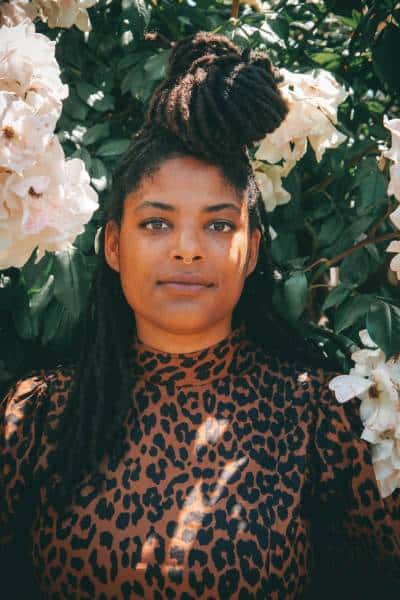
Photo by Terrellyn Faye
Paula is a Visual Storyteller whose work explores the healing intersection of Blackness and the natural world. Through mediums like film, photography, illustration, design, murals, painting, and printmaking, she weaves narratives that honor place, identity, and kinship with the earth. Inspired by the building’s architectural elements like the timber and reflection of nature, Paula will create large-scale two-dimensional artworks on five site-specific interior walls on each of the four levels of East County Library. The artworks will be placed in four high-traffic areas that include the building’s main elevator bays, accessing the parking garage, 1st and 2nd floors and rooftop deck. Currently, working on writing and illustrating her first children’s book, providing artwork for this library is a full-circle moment for Paula’s life-long support and passion for libraries.
Ka’ila Farrell-Smith: Living Room Walls
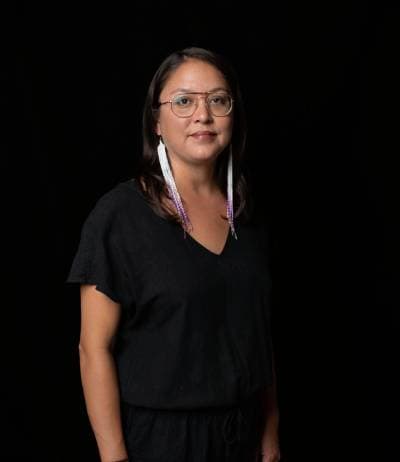
Photo courtesy of the artist
Ka’ila is a contemporary Klamath Modoc visual artist, writer and activist whose ancestral lands are in what is now known as Oregon and California. As part of her practice, she utilizes painting, drawing with wild-harvested pigments, and stenciling found-detritus. Ka’ila is creating large-scale, site-specific, wall-mounted 2-dimensional artworks for the grand two walls of the building’s central living room, a communal area in the heart of the library that encourages and fosters connection and learning. These walls frame the backdrop of the central living room which can be viewed from every corner of the new building, including the upstairs level. Ka’ila’s artwork is an opportunity for her to continue to explore the space in-between the Indigenous and western paradigms all the while instilling a sense of place, welcome and belonging as users of the library weave around the space.
Michaela Goade: Exterior Play Area Walls
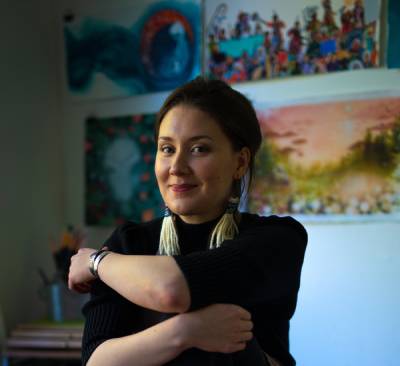
Photo by Bethany Goodrich
A Caldecott Medalist and #1 New York Times Bestselling illustrator, Michaela’s work focuses on Indigenous KidLit. An enrolled member of the Tlingit & Haida Indian Tribes of Alaska, Michaela is of the Kiks.ádi Clan (Raven/Frog) from Sheet’ká. Her 2022 children’s book, Berry Song, will be the focus of the library’s interior children’s area. In addition, Michaela will create a 2-dimensional artwork that will span the two large-scale walls in the exterior children’s play area, inspired by the characters and imagery of Berry Song. Honored by her work with Indigenous authors and tribal organizations in the creation of these beautiful and necessary books, this artwork provides Michaela another opportunity to bring visibility to Indigenous art-makers to share their stories with the broader community.
Crystal Schenk & Shelby Davis: North/South Exterior Plaza & Rooftop Deck
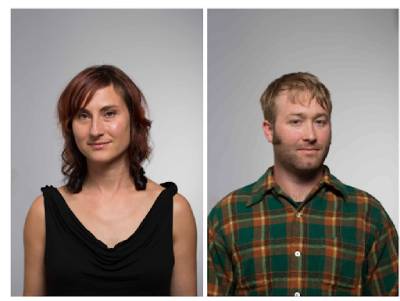
Photos courtesy of the artists
Known as CR&SH Studio Art, Crystal and Shelby are a husband and wife artist team whose collaborative work stems from a shared interest in storytelling, history and symbolism. They will create a series of site-specific exterior sculptural artworks that will be located in the plaza area that is along the building’s west elevation that runs north to south as well as along the perimeter of the seating area on the rooftop deck. These artworks are being referred to as “folley sculptures” because their locations will be situated within the landscape areas next to the plaza and the rooftop deck, serving as a nod to the architectural practice of building follies which enhance the visual aesthetic of an environment, traditionally in a garden. Crystal and Shelby have drawn inspiration both from the terrain of the environment surrounding the library and the various communities that will utilize the building’s services. Like many of their projects in the public sphere, these sculptures will possess moments of tranquility and reflection, giving the community the ability to engage with the artworks in surprising and unexpected ways.
Mike Suri & Terresa White: NW Eastman Parkway Sidewalk
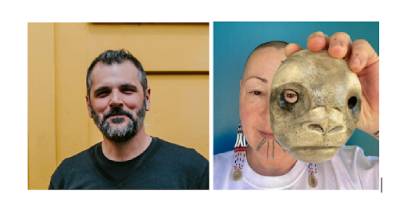
Photos courtesy of the artists
Mike Suri is a sculptor whose artworks respond to landscape, built environments, and personal history. His forged and cast metal forms are often heavy yet appear soft and invite inspection, touch, and reflection. As a ceramist and public artist, Terresa White is inspired by her Yup’ik heritage, including Yup’ik stories of transformation and the Yup’ik understanding of the interrelationship and spirit of all beings including human and animal people, water and sky people, river, sea, and rock, and beings we cannot see. Together they will create a series of free standing, sculptural artworks that will be prominently located along the building’s east exterior elevation. These artworks will be highly visible to pedestrian, bike and vehicular traffic along NW Eastman Parkway and partially visible from NW Division Street, two of the main arterial roads in Gresham. Mirroring their artistic collaboration, Mike and Terresa’s artworks will play a vital role in welcoming the community as they integrate both of their sculptural practices, weaving a narrative of belonging and interdependence.
These artworks are developed in coordination with the Regional Arts & Culture Council through the Multnomah County Percent for Art Program, allotting two percent of the construction budget for all county-funded improvement projects toward the investment in public art. Artists are awarded projects as part of a robust public process, which includes selection panels led by local residents, business owners, artists, library staff and project partners.
Libraries centering community-engaged art
Community engagement is at the center of the library’s building projects. Each library’s selection panel, made up of residents of the neighborhood, artists, architects, and library staff, considered many artists, including those with demonstrated experiences of engaging communities in their work. This includes multicultural understanding and representation as well as the ability to create meaningful connections to, and for, the community around each library.
The community will have the opportunity to contribute to the art in the library by attending a large art-making event at Gresham Library (385 NW Miller Ave, Gresham, OR 97030) on Wednesday, August 13 from 4-6:30pm. Artists Ka’ila Farrell-Smith and Paula Champagne will be facilitating multiple art activities for the community to participate in, including stencil-making, fabric weaving and silhouette portraits. This event is free, open to all and light refreshments will be provided. Those who attend will also have the chance to win an original art print.
###
About Multnomah County Library
A treasured community institution since 1864, Multnomah County Library is one of the nation’s busiest public library systems, providing social, educational and cultural programs, resources and services, online and through its 19 public locations. With an eye toward the future of community-centered spaces, the library is working to build, rebuild or expand eight libraries through a voter approved capital bond. In addition to being Oregon’s largest provider of free internet access, the library offers millions of print and digital resources, in multiple languages for people of all ages. From kindergarten readiness to job training, computer-assisted design and 3D printing, the library supports all people in their pursuits to connect, learn and create. Learn more at multcolib.org
About Regional Arts & Culture Council
The Regional Arts & Culture Council is a 501(c)(3) nonprofit organization that provides grants for artists and nonprofit organizations in Clackamas, Multnomah and Washington Counties; manages an internationally acclaimed public art program; convenes forums, networking events and other community gatherings; and provides workshops and other forms of technical assistance. RACC advocates for equity, inclusion and access, working to build a community in which everyone can participate in culture, creativity and the arts. For more information visit racc.org.
